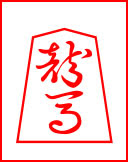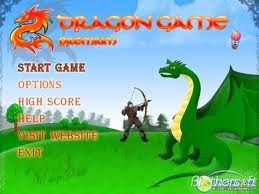:::::::::::::::::::::::::::::::::::::::::::::::::::::::::::::::::::::::::::::::::::::::::::::::::::::::::::::::::::::::::::
Games with Dragons
shoogi, shōgi 将棋 Shogi generals' chess.
also known as
Japanese chess,
is a two-player board game in the same family as Western chess, chaturanga, and Chinese xiangqi, and is the most popular of a family of chess variants native to Japan.
Shōgi means general's (shō 将) boardgame (gi 棋).
The earliest predecessor of the game, chaturanga, originated in India in the 6th century, and was brought to Japan sometime in the 10th to 12th centuries, where it spawned a number of variants. Shogi in its present form was played as early as the 16th century, while a direct ancestor without the "drop rule" was recorded from 1210 in a historical document Nichūreki, which is an edited copy of Shōchūreki and Kaichūreki from the late Heian period (ca. 1120).

Promoted rook ("Dragon")
Promoted rook 龍王 ryūō dragon king

Promoted bishop ("Horse")
Promoted bishop 龍馬 ryūma or ryūme dragon horse
© More in the WIKIPEDIA !
- quote -
..... Like Chess, you try to checkmate the opponent's king. The things that makes Shogi so great though, are drops and promotions. In Shogi, instead of killing pieces, they are captured, and you can place them back on the board to work for you.
It is believed this is because in 16th century Japan, mercenary groups would be captured, and could switch loyalties to avoid execution. In addition, promotion is vaguely similar to that of chess. When a piece reaches the back third of the board, it can promote.
- Instructions how to make a Shogi board :
- source : instructables.com -
.......................................................................

shoogi no hi 将棋の日 day of shogi
November 17
On this day the 8th Shogun Tokugawa Yoshimune declared this day with the first official shogi contest in Edo castle 御城将棋の日.
It was held since then from 1715 till 1745.
In rememberance, the Shogi association created this day in 1975.
................................................................................

Shared by Elaine Andre
Joys of Japan
Chopstick rests with Shogi patterns
................................................................................

Kitao Shigemasa 北尾 重政 (1739 – 1820)
見立琴棋書画 棋
. Edo shokunin 江戸の職人 Edo craftsmen .
shoogishi 将棋師 making Shogi tiles and boards
Tokugawa Ieyasu liked to play Shogi and it soon became a favorite pastime in Edo. Ieywasu founded a special Shogi Office with a head, iemoto 家元 to preserve the rules.
On hot summer evenings, men would sit outside the house and play Shogi, and even if they were not very skillful, neighbours came around and helped with advise and laughter.
kakikoma, kaki-koma 書き駒 handwritten Shogi piece

The lines on the Shogi board were hit with a long sword.
The most famous production area was
. Tendoo Shoogi 天童将棋 Tendo Shogi - Yamagata .
................................................................................
Matsuo Basho liked to play the game too and wrote two poems about it:
山桜将棊の盤も片荷かな
yamazakura shoogi no ban mo katani kana
mountain cherry blossoms -
half of the luggage carried
is the Shogi board . . .
(Maybe he had carried the tools for Hanami on a pole over the shoulder, and one half (katani) was the Shogi board game.
夏の夜や下手の将棋の一二番
natsu no yo ya heta no shoogi no ichi ni ban
this summer night -
an unskillful Shogi player's
first and second strike
from the collection 諸国象戯作物集 of 1700
The poems might have been written by 八段建部和歌夫.
There is anoother poem by Basho in a 連句 Renku
8th poem by 東藤 Todo
一輪咲し芍薬の花
- followed by Basho
棋の工夫二日とぢたる目を明て
There are no Shogi poems by Buson and Issa.
But this one is maybe by Issa
御負なり将棋の駒も駒の内
source : go.tengudo.jp/knowledge
. The Matsuo Basho Archives 松尾芭蕉 .
................................................................................
Tengu Shogi 天狗 (将棋)
a variant in the games of 大大将棋 Daidai Shogi, 泰将棋 Tai Shogi and
大局将棋 Taikyoku Shogi

Hook moves (changing tack)
The hook mover and long-nosed goblin (tengu) can move any number of squares along a straight line, as a normal ranging piece, but may also abruptly change tack left or right by 90° at any one place along the route, and then continue as a ranging piece. Turning a corner like this is optional.
Hook move:
The tengu can move any number of free squares along one of the four diagonal directions, then (optionally) make a 90° turn and move any number of free squares in a perpendicular diagonal direction.
It may only change directions once per move.
- source : wikipedia -

将棋の鬼 - - 天狗太郎将棋小説集
The author of this Shogi Novel is 天狗太郎 Tengu Taro.
. Tengupedia - 天狗ペディア - Tengu ABC-List .
................................................................................

CLICK for more playing cats !
. manekineko 招き猫 beckoning cat .
................................................................................
. Tendoo Shoogi 天童将棋 Tendo Shogi.
. Ryuume, the Dragon Horse.
. shoogidako, shoogi tako 将棋凧 Japanese Shogi chess kite .
:::::::::::::::::::::::::::::::::::::::::::::::::::::::::::::::::::::::::::::::::::::::::::::::::::::::::::::::::::::::::::
麻雀 マージャン Maajan, Mahjong
Mahjong, sometimes spelled Mah Jongg,
is a game that originated in China, commonly played by four players (with some three-player variations found in Korea and Japan). The four player table version should not be confused with the popular Western single player (tile matching) computer game (Mahjong solitaire), which is a recent invention and completely different from the table game. Similar to the Western card game rummy, mahjong is a game of skill, strategy and calculation and involves a certain degree of chance. In Asia, mahjong is also popularly played as a gambling game (though it may just as easily be played recreationally).
The game is played with a set of 136 tiles based on Chinese characters and symbols, although some regional variations use a different number of tiles. In most variations, each player begins by receiving thirteen tiles. In turn players draw and discard tiles until they complete a legal hand using the fourteenth drawn tile to form four groups (melds) and a pair (head).
There are fairly standard rules about how a piece is drawn, stolen from another player (melded), the use of basic (numbered tiles) and honours (winds and dragons), the kinds of melds, and the order of dealing and play. However there are many regional variations in the rules; in addition, the scoring system, the minimum hand necessary to win varies significantly based on the local rules being used.

The three dragon (cardinal) tiles
The Red, Green and White Dragon
There are two different honor suits:
the winds and the dragons.
the dragons are Red, Green and White
some winning hands with dragons
Pearl Dragon - All circles and a pong of the white dragon
Ruby Dragon - All characters and a pong of the red dragon
Jade Dragon - All bamboo and a pong of the green dragon
Great Dragons - Three pongs of all three dragons
© More in the WIKIPEDIA !
:::::::::::::::::::::::::::::::::::::::::::::::::::::::::::::::::::::::::::::::::::::::::::::::::::::
Dragons like to play computer games

source : instructionaldesignfusions
Dragon Tiles

- Rererence -
Dragon Game

- Rererence -
:::::::::::::::::::::::::::::::::::::::::::::::::::::::::::::::::::::::::::::::::::::::::::::::::::::
. Games with Daruma .
[ . BACK to WORLDKIGO . TOP . ]
[ . BACK to DARUMA MUSEUM TOP . ]
:::::::::::::::::::::::::::::::::::::::::::::::::::::::::::::::::::::::::::::::::::::::::::::::::::::








3 comments:
Tendo-shi shogi museum 天童市将棋資料館
We display document about world shogi and shogi including the history of piece.
.
and temple Koomyoo-In 光明院 Komyo-In
with Fudo Myo-O
.
and
Takamatsu Kannon hadaka mochitsuki
高松観音裸もちつき
pounding mochi rice cakes in the nude
November 17
Today is "Shōgi Day" in Japan!
This family of Japanese, chess-style strategy games, whose name means "General's game," takes in a host of variants, including Go (pictured, right). Shōgi enjoyed such popularity in the Edo period that eighth shōgun of the age, and confirmed fan, Tokugawa Yoshimune went so far as to organize a "castle shōgi" tournament each year on the 17th day of the 11th month of the old lunisolar calendar. Although that date actually corresponds with November 26 by modern reckoning, November 17 was chosen in 1975 by the Japan Shogi Association as the day to promote their pastime.
Find out more with this fascinating feature on the game:
https://www.youtube.com/watch?v=UBkT2bbVURk
Castle Games of the Edo Period
The Ôhashi records
An Eye-Witness Report Discovered by Masukawa Kôichi
Starting in June 1995, I have examined fragmentary scriptures from the traditional Shogi player family Ôhashi and was able to discover some twenty five hitherto unknown texts that deal in official manner with the annual tournaments of Go and Shogi at Edo Castle. The author of all these fragmentary records is the fifth head of the house of Ôhashi, called Ôhashi Sôkei the third. The records cover the thirty four years from 1674 to 1708. Here I would like to present the first record.
As an official report about the attendance of the players at the Castle of the Shogun, the record does not deal with the ordinary life of the players. Even so the author accounts what he actually heard and saw. Therefore we are able to learn many facts and details hitherto unknown to the history of Go and Shogi. The aim of the records was not merely to inform the posterity. They also served as documents when a new superior (the Commissioner of Temples and Shrines) requested information about precedents.
The tournaments at the Castle were held regularly since 1667, seven years before this record was written. At that time the officially sponsored houses of Go and Shogi were obliged to move from Kyoto to Edo. This was the time when many medieval leftovers in the administration were removed by new provisions. Correspondingly, the roles of the players too seem to have taken a definite shape then.
.
more by
Author: Masukawa Kôichi,
transl. Bernhard Scheid
.
http://pokspace.goverband.at/essays/masukawa.htm
.
Post a Comment